
Why is your grass dying even though you water it? Too much or too little water, compact soil, incorrect mowing habits, bugs on the loose, or sneaky fungus might be the culprits messing with your green yard.
Pinning down the problem is key. You might have to ease up on the mowing, look for pests, balance your soil’s pH, or maybe even start fresh with a new grass. We’ll cover seven possibilities and provide a brief solution for each.
1. Overwatering or Underwatering
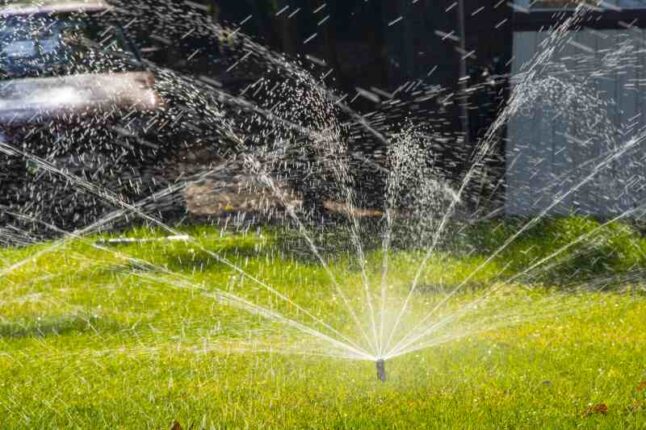
Annoying as it may sound, both extremes can give your grass blues. You may be flooding those poor blades without noticing, effectively drowning them into their early graves. How is this possible? Overwatering can suffocate grass roots by filling soil pores with water and depriving them of oxygen.
Plus, soggy laws are breeding grounds for fungi that lead to diseases like root rot or leaf spot.
On the flip side of this is dehydration. If you don’t water your lawn enough, especially during those hot sunny days, the grass can brown and even go dormant. In serious cases of neglect and intense heat, it might just die off.
So what’s ideal? Well, this depends on several factors, such as:
- Local climate;
- Season;
- Type of grass;
- Soil type.
Generally speaking, most lawns do well with 1 to 1.5 inches of water per week (during hot seasons), divided into two or three waterings.
Pro Tips for Lawn Watering
- Get your watering done early in the morning, between 4 and 8 a.m. It cuts down on water wasted to evaporation and allows grass to dry before nightfall.
- Go for a good soak rather than a daily sprinkle to encourage those roots to stretch down deep (here’s our guide on How Long to Water Your Lawn in Summer)
- Adjust watering based on rainfall, temperature, and soil type. Clay soils retain more moisture than sandy soils.
- To make sure you’re giving your lawn an even drink, install several rain gauges or empty tuna cans out there. Why tuna can? Because that’s about one inch tall, which is a good weekly watering goal.
- Watch for signs that it’s time to water: if your footprints stay on the grass or the blades look folded up or dull, then it’s thirsty time.
2. Pest Invasion
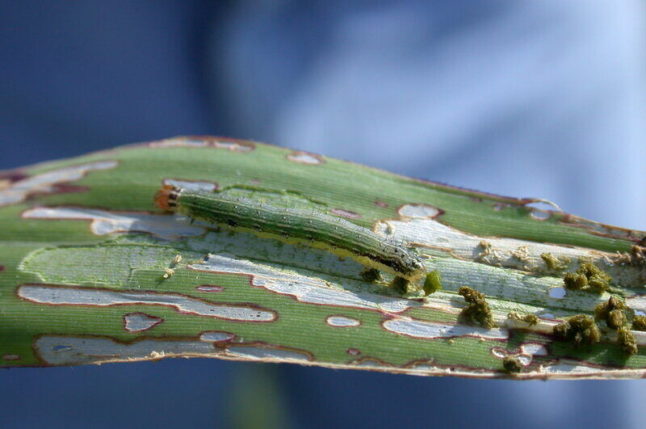
Just like your bedroom could be invaded by frustrating bed bugs, your lawn can also become the feast of choice for many pesky insects. And unlike you in the comfort of your home, grass has no means to flee or fight back.
Here are some common lawn pests:
- Armyworms: Brown, green, or gray worms that feed on grass blades. Learn how to identify armyworms in our comprehensive guide.
- White Grubs: C-shaped, white, or cream-colored grubs that feed on grass roots. Visit our guide to learn how and when to kill lawn grubs.
- Billbugs: These tiny, long-snouted beetles are either black or gray. Their white, legless grub larvas munch on grass stems and roots. This results in patches of brown, lifeless grass. Here is our guide on how to identify and control billbugs in your lawn.
- Chinch Bugs Adults: They are little black critters with white markings on their wings. They juice up on your grass and leave it yellow. Learn what exactly are chinch bugs and how to get rid of chinch bugs for good with our easy-to-follow article.
- Sod Webworms: Small gray or white or gray moths with caterpillars create brow patches on your lawn. Get rid of these sod webworms by treating grass blades in stems.
Pro Tips for Controlling Lawn Pests
- Go Natural: Birds, spiders, ants, and ground beetles are the good guys for your lawn. They chow down on the insects that damage the grass. Besides predators, there are other easy-going natural ways to keep pests away, including beneficial nematodes, neem oil spray, or insecticidal soap.
- Bring on the Chemicals (Only When Necessary): If the infestation is too large or too developed for natural solutions to be effective, there’s always the trusty pesticide approach. Follow the instructions very carefully and use these products sparingly. Try to target only the affected areas rather than the entire landscape.
*Note: Many chemicals can also harm beneficial insects and disrupt the lawn’s natural ecosystem. So, a pest control expert could be worth consulting to ensure minimal harm to your lawn’s friendly bugs.
3. Incorrect Mowing
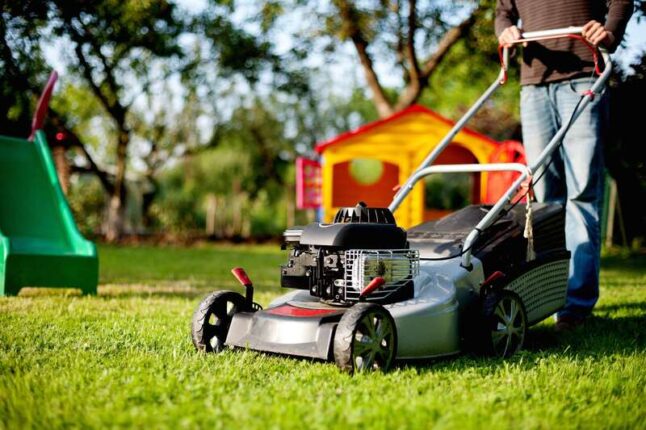
Lawn ‘haircut’ day shouldn’t turn into a massacre. If you’re cutting your lawn too short, stop. This isn’t a military buzz cut we’re aiming for – think more along the lines of gracefully long layers.
Trimming the grass too short can expose the soil to the sun’s harsh rays, which can dry it out. It also weakens grass blades, leaving the risk of disease and bug attacks as they have less leaf surface area to conduct photosynthesis.
However, it’s not just short trims that can be an issue – irregular mowing isn’t ideal either. Procrastinate with mowing, and you might end up with tall grass that gets cut down drastically.
Pro Lawn Mowing Tips
- Avoid ‘Scalping’ the Lawn: Follow the ‘one-third rule.’ Never remove more than one-third of the total grass blade length at one time. This allows clippings to decompose and provide vital nutrients back to the soil, promoting a healthier, greener lawn.
- Weather-Based Mowing: During dry spells, ease up on mowing; taller grass helps save water and safeguards your lawn.
- Keep Those Mower Blades Sharp: Aim to give them a tune-up every 20 to 25 hours of mowing. Why? Sharp blades mean clean-cut and healthy, green grass. Dull ones tear the grass, leading to a not-so-pretty brown lawn.
- Leave Clippings on Your Lawn: Grass clippings are perfect mini fertilizer bombs.
If you’re unsure about your mowing habits, take a peek at our guide Lawn Mowing Tips: How to Mow a Lawn the Right Way. It’s got all the advice you need to fine-tune your technique and loads of extra hints to help you mow like a pro.
4. Soil Compaction
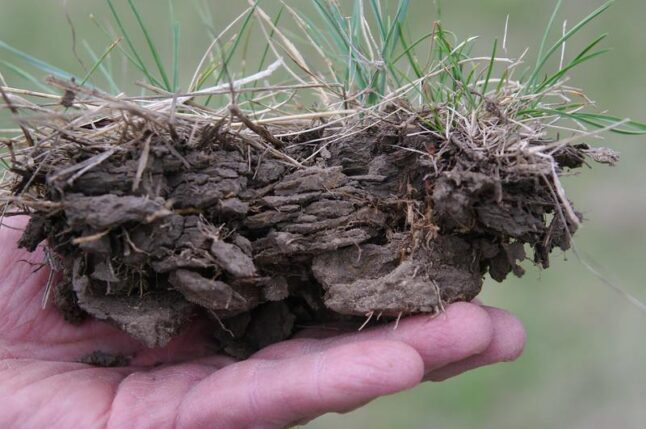
Compact soil is akin to a stuffy, cramped room where you can barely move – you might survive, but thriving is out of the question. Your grassroots feel much the same way if there’s soil compaction.
Watering and moving around (mowing or playing with your dog) on the lawn leads to compaction, leading to less air for roots and harder paths for water infiltration. The result? Grass that struggles to get life-supporting nutrients.
Is compaction your issue? Here are the signs of soil compaction:
- Resistance – Get a regular screwdriver and poke it into your lawn. If there’s resistance, chances are you’re dealing with compact soil.
- Puddling: If rainwater or sprinkler water is hanging out in little pools on the grass, it’s saying, ‘Hey, I’m having a tough time getting through.’
- Runoff: If water heads off fast down slopes instead of sinking into the ground, that’s a red flag. This runoff means compaction is preventing absorption and effectively leaving your grass high and dry.
- Soil Type: Heavy clay soil has tiny particles that stick close together, which means air and water don’t move through it as easily as in looser, sandy soils. That’s why your clay soil gets packed down pretty quickly.
- Recent Activity: Has your yard seen a lot of action lately? Perhaps with kids running around or large equipment sitting on the lawn? These high-pressure activities can compress soil particles, leading to stubborn compaction over time.
Compaction Remedy Pro Tips
Loosen up that dense dirt with aeration – poking small holes in the lawn gives your grass more room to breathe and grow. You can rent an aerator or hire a professional lawn care service depending on the size of your problem (or should we say lawn).
This is best done during the growing season, when the grass can heal itself after aeration.
Cool-season grasses like ryegrass and bluegrass thrive with fall aeration, while warm-season grasses such as Bermuda and Zoysia are more comfortable with the late spring to early summer tickling. (Here’s our guide on Compacted Soil: Causes and Cures for Your Lawn)
5. Diseases and Fungi
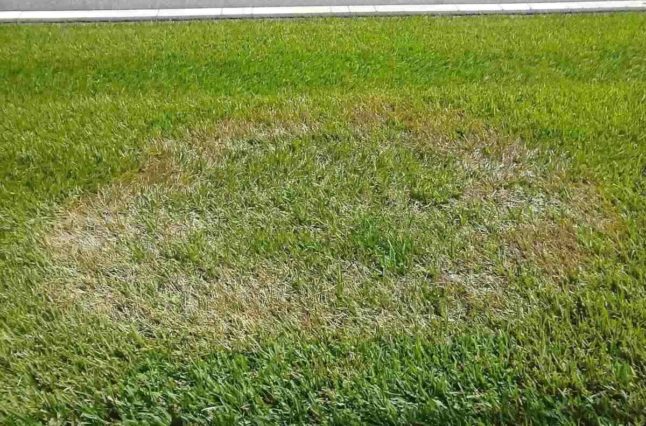
Observing those brown patches, you might jump to the conclusion that they’re caused by under-watering and think, ‘Sprinkle more water, right?’ Wrong. It could be fungi working quietly behind the scenes to sabotage your once lush lawn. Hence, before reaching for the hose, let’s check for signs of disease.
When it’s extra humid for too long, fungal spores wake up and go to town on your turf. Look out for symptoms like:
- Dollar spots; (here’s our guide on How to Get Rid of Dollar Spot)
- Brown grass patches;
- Rust.
We know these trouble spots can easily pass off as just needing some nutrients or a good drink. But give it a second look and factor in how much you’ve been watering and what the weather’s been like lately:
- Has it been particularly humid with a lot of rain recently?
- Did you end up watering too late in the day, leaving the grass blades wet overnight?
Both scenarios can encourage fungal growth.
Lawn Fungus vs. Dry or Nutrient-Deficient Soil Signs
| Signs of Lawn Fungus | Signs of Dry or Nutrient-Deficient Soil |
| Irregular patches, rings, or spots of discolored grass; | Grass parched from dryness will uniformly wilt. |
| Discolored grass that may appear brown, yellow, or red-purple | It will turn a bluish-gray color before browning. |
| Visible fungal growth such as powdery coatings, slimy films, or thread-like structures on the grass blades. | Retain visible footprints or mower tracks due to the grass blades losing their ability to spring back up. |
Figuring out what’s messing with your lawn can be tricky since there are so many possible culprits. To simplify things, we’ve compiled a complete guide called ‘Common Lawn Diseases and How to Identify Them.’ It’s jam-packed with simple ways to spot the usual suspects and tips on how to deal with them
Pro Tips for Controlling Lawn Disease
- Baking Soda Mix: Stir one tablespoon of baking soda into a gallon of water with a few drops of dish soap. Spray this on any sick-looking spots in your grass to fight off fungus like powdery mildew.
- Neem Oil: This plant-based oil has both fungicidal and insecticidal properties. Mix with water as directed on the label and spray over the affected area.
- Water Just Right: Not too much or too often – the soil should dry out between waterings, which keeps things less inviting for fungi.
- Keep Your Lawn Clean: Remove fallen leaves and other debris that may serve as briefing grounds for fungi.
- Let Your Lawn Breathe: Aerate and dethatch regularly to improve drainage and reduce thatch buildup.
- Chemical Control: If you’ve given natural fixes a shot and your lawn’s still looking under the weather, it might be time to call in some backup with fungicides, such as Myclobutanil, Propiconazole, and Triadimefon. (Here is our complete guide on Lawn Fungus Treatments: Costs, Types, and Do They Work?)
- Safety: Always keep safety in mind when you’re handling fungicides or any kind of lawn chemicals. Follow manufacturers’ instructions on application rates, methods, and timing to get its full effect safely.
- Hire a Pro: It’s safer and more effective to consult a lawn care professional who can properly diagnose and treat the problem.
6. Pet Waste
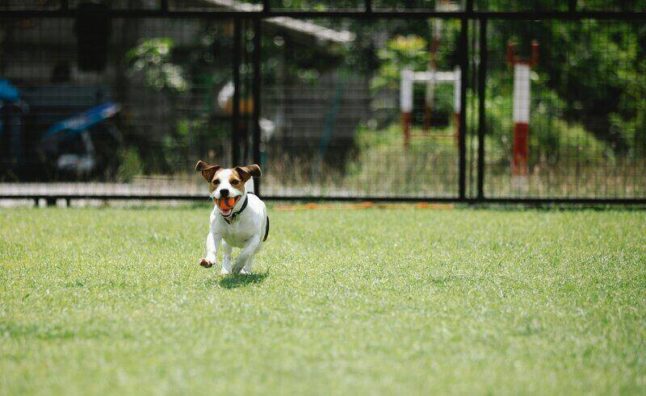
Pets are a bundle of joy, but their messes? Not so much. Their waste can quickly ruin a green lawn, and well… that definitely puts the ‘pet’ in petty.
But before you cringe at the prospect of picking up after your four-legged pal, remember that neglecting this duty could turn sections of your lawn into ground zero for ‘fertilizer burn.’
While pet waste technically is a natural fertilizer, it’s also high in nitrogen. Small amounts can be beneficial to your grass, but large clumps left to decompose will create concentrated patches of high-nitrogen material. The result? Burnt brown spot on your lawn encircled by lush green rings – an unsightly stain that screams ‘pet business here’ to anyone looking.
Pro Tips for Dealing with Pet Waste on Your Lawn
- Soak the affected areas thoroughly with water immediately after your pet pee. This can really help in diluting nitrogen and salts that cause lawn burns.
- If the grass is already brown but not completely dead, perk it up with a soil-cleansing treatment made specifically for pet urine. It’s quick and eases the nitrogen overload.
- If the spots are just too far gone, it might be time to reseed. Rip out the damaged bits and plant some fresh grass seed.
- Adopt the mantra of “scoop, bag it and bin it.” Basic as it might sound, swift poop cleanups could save you from many patchy lawn scenarios. A small shovel or poop scoop comes in handy for quick pickups.
- Avoid over-fertilizing your lawn, especially in areas where your dog pees.
- Train your dog to urinate in designated areas, like gravel or mulch patches.
7. Poor Soil Quality
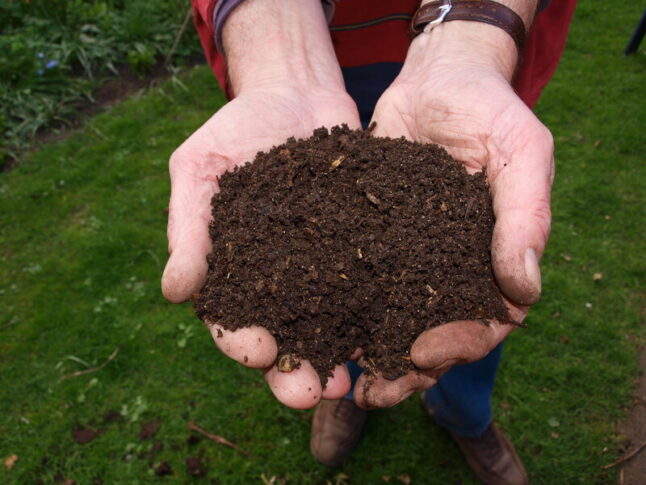
Have you ever felt like you’re sorely lacking nutrients and struggling to keep your eyes open? Maybe that morning, multi-vitamin just isn’t cutting it. Your grass’s nutrient intake is directly linked to the quality of the soil. And no, it doesn’t just rely on water and sunshine to grow loud and proud.
If your soil is out of balance – be it too alkaline, acidic, or lacking in key nutrients – your grass might start to deteriorate. Grass thrives in loamy soil with a good mix of sand, clay, and silt combined.
The ideal pH for growing healthy lawn grasses ranges between 5.8 to 7.2.
*Note: Soil imbalance can interfere with how the plants absorb nutrients from the soil, leading roots to become stressed and unable to take up water properly, making your yard more likely to suffer drought damage.
How do you check soil quality?
One sure-shot way of knowing your soil’s needs is by conducting a soil test. These are essentially physicals for your turf – a head-to-toe exam that pinpoints your soil’s pH balance and nutrient levels.
Signs your soil might be nutrient-poor include:
- Pale or yellow grass color rather than a rich green.
- Slowed grass growth is thin, with sparse patches in the lawn.
- Presence of weeds that outpaces grass growth.
Pro Tips for Improving Soil Quality
- Watch Your pH: If your lawn is too acidic (a pH below 6), it’s lime time. (Here’s the lowdown on liming your lawn: why, when, and how. It’s all in this guide; super easy to follow. Stick to some basic rules and you’ll have your lawn looking fresh in no time.
If it’s too alkaline (pH above 7), try adding sulfur slowly over a few seasons to bring the balance back.
- Choose the Right Fertilizer: Some lawns might want potassium, and some others need more nitrogen. Your soil test result will guide you here.
- Be Timely With Your Fertilizing: this isn’t a year-round task – typically, spring and fall are best for most grass types as they prepare to grow/become dormant.
- Organic Amendments: Compost, manure, or bone meal can all add nutrients back to your soil more gently and sustainably than synthetic fertilizers.
FAQ About Dying Grass
Why is my grass turning brown?
Grass turning brown can be due to inconsistent watering, overfertilizing, compact soil, pests, or disease. It could also signal improper mowing or nutrient-deficient soil. Rule out each possibility systematically.
Should I remove dead grass?
Yes. Removing thatch – old grass stems and roots – improves your lawn’s overall health. It allows more water, air, and nutrients to reach your turf’s green (living) parts, promoting deeper root system development and lusher green growth. Early fall or spring is often the best time for dethatching.
Will grass come back if it dies?
It largely depends on its health before dying and how severe the damage is. If only the blades are brown, but the roots still thrive, lawn rejuvenation is possible with care such as watering, fertilizing, and mowing at the correct height. However, bald patches devoid of root structure may need reseeding for a lush comeback.
Green Up Your Lawn with Pro Help
Just because your lawn looks a little brown doesn’t mean it’s beyond repair. Most of the time, all it needs is some minor tweaks in how you water, mow, or maintain your lawn. Remember that lawns have different needs based on the type of grass, weather conditions, and soil. Once you nail down the cause, your grass will rebound.
But, sometimes, those pesky brown patches can be tricky. They might need something more advanced, like special chemical treatments to get rid of bugs or fungi. If you tried every DIY trick in the book to revive your lawn and it’s still on the brown side, then dear homeowner, it’s time to tag in a local lawn care pro. Bringing them in offers some cool perks, including expert treatment, zero guesswork, and peace of mind.
Main Photo Credit: Adobe Stock